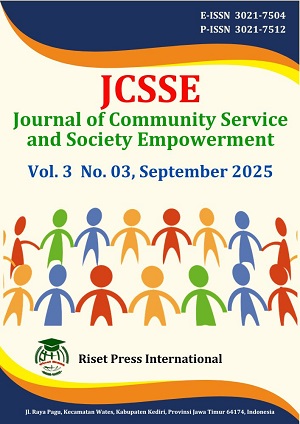Training for Making Local Woven Motifs with Textile Painting
DOI:
https://doi.org/10.59653/jcsse.v3i03.1961Keywords:
training, textile painting, local woven, motifsAbstract
The community service activity entitled, "Training in making local woven motifs based on textile painting techniques" was held on May, 2025. This activity was the result of a collaboration between the community service team and the Pondok Suraya Creative Center Studio which focuses on developing artistic creativity based on local culture. The main objective of this activity was to increase the knowledge and skills of studio members in understanding and applying the richness of typical Southeast Sulawesi woven motifs into alternative media, namely textile painting. The method used was community education through presentation of community service and training materials. This activity demonstrates the participants' ability to re-explain the meaning and types of Southeast Sulawesi woven motifs, as well as the accuracy in applying motifs to textile paintings. This achievement is seen as important as part of cultural preservation as well as a strategy for empowering creative communities.
Downloads
References
Adriani, N. L. P. N. C., Pranajaya, I. K., & Suyoga, I. P. G. (2025). Transformation and Aesthetics of Traditional Grinsing Handwoven textile Textile Motifs as Decorative Elements in Modern Interior Design (A Timeless Beauty of Modern Artistry). Law and Humanities Quarterly Reviews, 4(1). https://doi.org/10.31014/aior.1996.04.01.144
Chudi-Duru, C. (2023). Textile Painting: Exploration of Uli Symbolic Motifpainting of the Igbo on Dyed Canvas Using Acrylic as a Medium in Contemporary Textile Art. Journal of Fine Arts, 5(1), 1–11. https://doi.org/10.22259/2637-5885.0501001
Cross, L. D. (2003). Woven, Not Carved: The Pangnirtung Tapestries are Northern Art with Global Appeal. Arctic, 56(3), 310–314. https://doi.org/10.14430/arctic627
Hani, W. O. D. P., Amaluddin, L. O., Surdin, & Andrias. (2024). Eksistensi Tradisi Bertenun dan Implikasinya Terhadap Masyarakat. Jurnal Penelitian Pendidikan Geografi, 9(2), 80–82. https://jppg.uho.ac.id/index.php/journal/article/view/154
Howard, E., & Opoku-Asare, N. (2012). Assessing the Suitability of Woven Fabric and Composite Textile Techniques for Mural Production. Journal of Science and Technology (Ghana), 32(1), 140–149. https://doi.org/10.4314/just.v32i1.14
Jatmika, S. H. W. (2022). Peningkatan Kreativitas Berkarya Seni Rupa Materi Penerapan Ragam Hias pada Bahan Tekstil Melalui Praktik Membatik dengan Teknik Lukis Siswa Kelas VII A SMP Negeri 2 Panggul. Jurnal Simki Pedagogia, 5(2), 179–191. https://doi.org/10.29407/jsp.v5i2.136
Nuraini, S., & Falah, A. M. (2022). Eksistensi Kain Tenun di Era Modern. ATRAT: Jurnal Seni Rupa, 10(2), 162–169.
Ode Monto Bauto, L., & Anggraini, D. (2023). Kajian Eksistensi Nilai-Nilai Dan Makna Motif Kerajinan Kain Tenun Tradisional Etnis Kulisusu. 8(4), 253–261.
Pabottingi, A. H., Asse, A., Erwin, S., Almuhajir, A., & Yasmin, Y. (2001). Tenunan Tradisional Buton. Pemerintah Propinsi Sulawesi Tenggara Dinas Pendidikan dan Kebudayaan Museum Negeri Propinsi Sulawesi Tenggara.
Pöllänen, Sinikka Hannele. Weissmann-Hanski, M. K. (2020). Hand-made well-being: Textile crafts as a source of eudaimonic well-being. Journal of Leisure Research, 51(3), 348– 365.
Pöllänen, S. H. (2015). Elements of Craft that Enhance Well-Being: Textile Craft Makers’ Description of Their Leasure Activity. Journal of Leisure Research 47 (1), 58-78, 47(1), 58–78.
Saypanova, G. K. (2024). Ethnography Of Patterns: Understanding Cultural Expressions through Design dnd Symbolism. Академические Исследования в Современной Науке, 3(46), 19–22.
Tamburini, D., Dyer, J., Heady, T., Derham, A., Kim-Marandet, M., Pullan, M., Luk, Y. P., & Ramos, I. (2021). Bordering on asian paintings: Dye analysis of textile borders and mount elements to complement research on asian pictorial art. Heritage, 4(4), 4344– 4365. https://doi.org/10.3390/heritage4040240
Thompson, K., Smith, M., & Lennard, F. (2017). A literature review of analytical techniques for materials characterisation of painted textiles—Part 1: categorising painted textiles, sampling and the use of optical tools. Journal of the Institute of Conservation, 40(1), 64–82. https://doi.org/10.1080/19455224.2016.1269355
Ulfa, S., br Sinulingga, T. E., & Sinulingga, J. (2023). Kain Tenun Tradisional: Warisan Budaya dan Industri Kreatif. Jurnal Pendidikan Tambusai, 7(3), 29709–29715. https://www.jptam.org/index.php/jptam/article/view/11780
Waktole, D. H. (2016). Cultural Values of Customary Handicraft. Socrates, 4(2), 15–26. https://socratesjournal.com/index.php/SOCRATES/article/view/197
Wening, S., & Kusumadewi, P. D. A. (2023). Tren berkain generasi Z: Peluang pengembangan industri kreatif bidang busana. Prosiding Pendidikan Teknik Boga Busana FT UNY, 18(1), 1–8. https://www.kompasiana.com/sherlypermatasari/
Downloads
Published
How to Cite
Issue
Section
License
Copyright (c) 2025 Salniwati, Nurtikawati

This work is licensed under a Creative Commons Attribution-ShareAlike 4.0 International License.
Authors who publish with this journal agree to the following terms:
- Authors retain copyright and grant the journal right of first publication with the work simultaneously licensed under a Creative Commons Attribution-ShareAlike that allows others to share the work with an acknowledgement of the work's authorship and initial publication in this journal.
- Authors are able to enter into separate, additional contractual arrangements for the non-exclusive distribution of the journal's published version of the work (e.g., post it to an institutional repository or publish it in a book), with an acknowledgement of its initial publication in this journal.
- Authors are permitted and encouraged to post their work online (e.g., in institutional repositories or on their website) prior to and during the submission process, as it can lead to productive exchanges, as well as earlier and greater citation of published work (See The Effect of Open Access).























